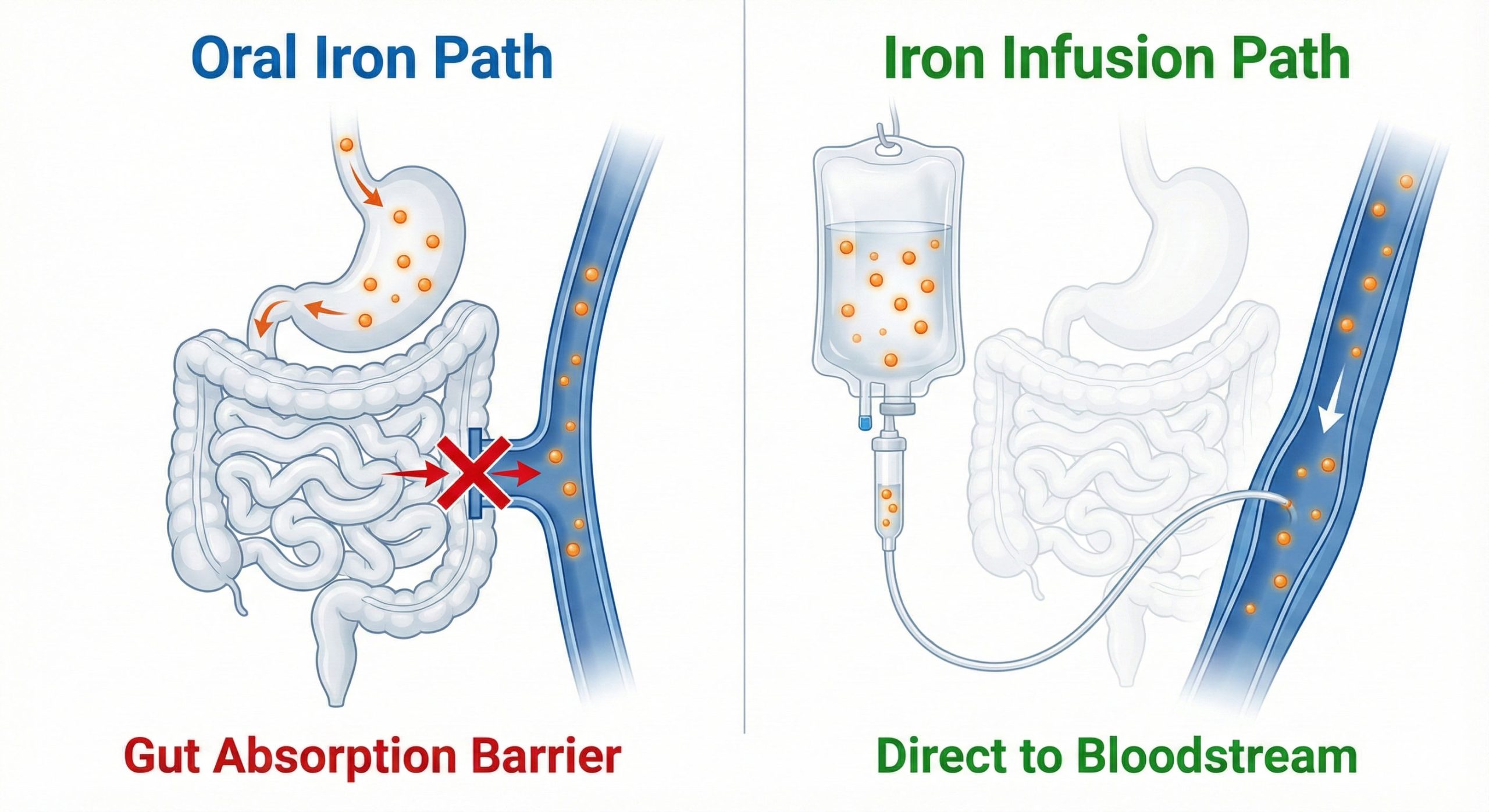Energy in the human body is primarily produced through cellular processes that involve breaking down nutrients from food. The mitochondria, often described as the energy-producing structures within cells, generate a molecule called ATP (adenosine triphosphate), which powers almost every biological function.
To support this process, the body relies on a steady supply of key vitamins, minerals, oxygen, and hydration. Nutrients such as B vitamins, magnesium, and iron play important roles in converting food into usable energy. When these elements are lacking, either due to poor intake or absorption issues, the body may struggle to keep up with its energy demands, leading to fatigue.
In some cases, and under clinical supervision, patients in Australia may be referred for intravenous nutrient support. Access to IV infusions in Melbourne is available for individuals who require medically guided repletion, particularly when oral intake has proven ineffective or inappropriate.
Factors That Can Contribute to Low Energy
Low energy levels can result from a wide range of causes. It’s not always due to one factor, and it often reflects a combination of lifestyle habits, underlying health issues, or temporary disruptions. Common contributors include:
- Inadequate sleep or disrupted sleep cycles
- Chronic stress or emotional strain
- Poor dietary intake or nutrient imbalances
- Dehydration
- Hormonal changes
- Certain medical conditions such as anaemia, thyroid disorders, or infections
Identifying the root cause of fatigue usually requires a full clinical picture, including blood tests, health history, and symptom review.
What Is IV Therapy and When Is It Used?
IV therapy refers to the process of delivering nutrients directly into the bloodstream through a vein. This method is typically used in medical settings when a patient cannot meet their nutritional needs through food or oral supplements. It allows for the controlled delivery of fluids, vitamins, and minerals under clinical supervision. In Australia, IV nutrient therapy is sometimes offered to patients whose digestive function is impaired or whose absorption is compromised due to illness, surgery, or medication use. It is not a general wellness service and is only offered based on individual health assessments.
Nutrients Commonly Used in IV Therapy
IV therapy may include specific vitamins and minerals that support normal metabolic processes. These are selected based on the patient’s needs, recent pathology, and clinical judgement.
Common nutrients that may be included are:
- Vitamin B12, which plays a role in red blood cell production and neurological function
- Magnesium, involved in over 300 enzymatic reactions, including those related to muscle and nerve function
- Vitamin C, a water-soluble antioxidant that supports cellular function and immune response
- Other B-complex vitamins, which assist with converting food into cellular energy
All inclusions are reviewed on a case-by-case basis and administered under medical guidance.
Is There a Link Between Nutrient Status and Energy?
Several nutrients are involved in energy metabolism, and deficiencies in these may contribute to fatigue. For example, a lack of iron, B12, or certain B vitamins can affect red blood cell production and oxygen delivery to tissues. In some people, correcting a deficiency may help restore normal energy function. However, it’s important to note that not all fatigue is caused by nutrient depletion, and supplementation is only appropriate when a clinical need is identified. IV therapy is not a substitute for proper diagnosis or ongoing care but may be considered in specific scenarios where nutrient restoration is needed quickly or absorption is impaired.
How IV Therapy Differs From Oral Supplementation
The main difference between IV and oral nutrient delivery lies in how the body absorbs the nutrients. Oral supplements must pass through the digestive tract, where absorption can be affected by stomach acid, gut health, or medications. In contrast, IV therapy bypasses the gastrointestinal system entirely, delivering nutrients directly into the bloodstream. This can be helpful when fast repletion is required or when oral supplements have not worked effectively.
However, IV therapy is not superior in all cases. For many people, oral intake is adequate and more appropriate. The decision to use IV therapy is made based on individual medical factors, not preference.
IV Therapy as a Delivery Method
When clinically indicated, IV therapy may be used as a temporary tool to correct certain deficiencies. It is not intended as a long-term energy solution or regular treatment for fatigue. IV therapy must always be prescribed by a qualified healthcare professional and is carried out in a supervised medical setting. At Clarendon Medical, patients undergo assessment before any treatment is considered, and IV therapy is only offered when medically appropriate. The goal is to ensure safety, relevance, and evidence-based care for each person’s circumstances.
Who Might Be Suitable for IV Nutrient Therapy?
Not everyone experiencing fatigue will benefit from IV therapy. A doctor will first assess whether there’s a medical reason to consider intravenous treatment. Suitability may depend on factors such as:
- Documented nutrient deficiencies
- History of poor absorption or gut-related conditions
- Difficulty tolerating oral supplements
- Nutritional needs related to surgery or illness
- Results of recent blood tests and clinical symptoms
In some cases, IV therapy may be considered alongside other interventions as part of a broader management plan.
Are There Risks or Limitations?
As with any medical treatment, IV therapy carries potential risks. Common side effects include mild discomfort at the injection site, bruising, or a temporary metallic taste in the mouth. Less commonly, some patients may experience light-headedness or allergic reactions. Serious side effects are rare but can occur, which is why medical supervision is essential.
It’s also important to be aware of limitations. IV therapy will not resolve fatigue that stems from lifestyle stress, sleep deprivation, mental health concerns, or undiagnosed medical conditions. It should never be viewed as a shortcut to improved energy without understanding the underlying cause.
What IV Therapy Cannot Address
IV therapy is not a general cure for tiredness or low mood. It cannot replace rest, proper nutrition, physical activity, or mental health support. If energy issues stem from sleep deprivation, anxiety, burnout, or hormonal imbalances, IV therapy is unlikely to offer lasting benefit. This is why assessment is crucial — to ensure that any treatment aligns with the actual cause of fatigue. Clear patient expectations are key, and long-term reliance on IV therapy without addressing root causes is not recommended.
Clarendon Medical’s Clinical Approach to Fatigue
At Clarendon Medical, fatigue is approached through comprehensive consultation. This may include reviewing your health history, current symptoms, lifestyle patterns, and diagnostic testing. If a nutrient deficiency is identified and IV therapy is considered appropriate, the process is explained in detail and tailored to your needs. Treatment is delivered by trained medical staff in a calm, clinical environment. IV therapy is one of several tools available, used only where it adds genuine value to patient care. Your wellbeing and safety are always the first priority.
What to Expect if You’re Referred for IV Therapy
If IV therapy is recommended, your GP will explain the procedure and what to expect. You’ll attend a scheduled appointment at the clinic where a nurse or doctor will insert a small cannula into a vein, typically in the arm. The infusion process generally lasts between 30 and 60 minutes, depending on the formulation and volume.
During the session, you’ll remain seated or reclined and may be monitored for any immediate reactions. After the infusion, you’ll usually be observed briefly before being able to go home. Most patients can resume normal activities afterward, though some prefer to rest for the remainder of the day.
FAQs
Q1: Can IV therapy help with tiredness or burnout?
A1: IV therapy may support energy production when a diagnosed nutrient deficiency is involved. It is not a treatment for lifestyle-related fatigue, burnout, or emotional stress.
Q2: How soon might I feel a difference?
A2: Some people report feeling more alert or energetic within a few days, but results vary. It depends on your underlying condition, the nutrients given, and your overall health.
Q3: How do I know if IV therapy is suitable for me?
A3: Suitability is assessed by your doctor after reviewing blood tests, symptoms, and medical history. It’s not appropriate for everyone and is only offered when medically necessary.
Q4: Are there any risks with IV therapy?
A4: Minor side effects like bruising, a metallic taste, or tiredness can occur. More serious reactions are rare but possible. All treatments are done under clinical supervision.
Q5: Can I choose to have IV therapy for energy without a referral?
A5: No. IV therapy is a medical treatment and is only provided following a GP consultation and clinical assessment.
Disclaimer
This article is intended for general informational purposes only and does not constitute medical advice. Always consult your doctor or qualified healthcare provider to determine whether IV therapy is appropriate for your needs. All medical treatments, including IV nutrient therapy, must be prescribed and supervised by a licensed practitioner in accordance with Australian medical regulations.



